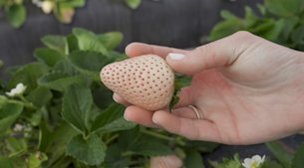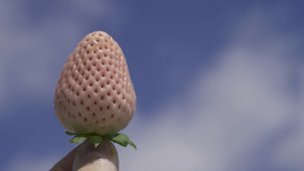Article from Specialty Crop Grower
by Vance M. Whitaker
Strawberry Spotlight: Update on Florida Pearl™ Pineberry

The patented Florida Pearl™ (FL 16.78-109) pineberry is a newcomer
on the U.S. berry market in the last two years. It has appeared in
stores under multiple brand names, including Pinkaboo and Berry De
Blanc.
ABOUT THE BERRY
Pearl has white flesh inside and out,
with a pink blush on the outside when ripe. The seeds also turn bright
red when ripe, giving this fruit a color scheme that is like a red
strawberry in reverse. The texture of Florida Pearl™ is a little bit
softer than red strawberries, and the flavor is characterized by low
acidity and a subtle pineapple aroma.
Fruit are harvested into
single-layer, 10-ounce clamshells, providing distinct packaging to go
along with a distinct appearance and flavor. The hope is that, in time,
pineberries will be established as a fifth berry in U.S. supermarkets,
along with red strawberries, blueberries, blackberries and raspberries.
Pineberries
are essentially white strawberries and belong to the same species as
the red strawberries that we all know and love. White forms of
strawberries exist in nature, and breeders have been harnessing these
forms in recent years by crossing them with modern red strawberries.
The
source of white color in Florida Pearl™ comes from Japan, where white
strawberries have been prized for several years. The first cross
between the Japanese source and red strawberries was made in 2012.
These first seedlings had small fruit and low yield, but after a second
cross back to red strawberries in 2016, the resulting plants had more
typical fruit size and yield, except with white color. Florida Pearl™
was commercialized by the University of Florida (UF) strawberry
breeding program in 2020.

OUTLOOK OPTIMISTIC
During
the 2021–22 season, about 150 acres of Florida Pearl™ were grown in
Central Florida. Similar acreage is being grown in California this
summer to provide closer to year-round availability. Next season, the
acreage is expected to double in Florida, with about 300 acres. The
yield of Florida Pearl™ in Florida has been about 75% of the yield of
Florida Brilliance, which is the leading red variety. It is also
somewhat later-yielding, with a slower start to the season in December.
Nevertheless, the variety has been profitable due to rapid acceptance
at retail and relatively high prices thus far.
At present,
Florida Pearl™ is exclusive to Florida-based companies, as are all UF
strawberry varieties in the first three years after commercialization.
However, a limited number of trials are being allowed with permission
from the Florida Strawberry Growers Association (FSGA). In 2023, the
three-year Florida exclusive window will close, and Florida Pearl™ will
be more widely available.
Growers who are interested in planting
the pineberry in the fall of 2023 with the intent to provide fruit to
retail supermarkets should contact the FSGA to discuss a fruit-growing
license. Initial trials have been conducted in high-tunnel production
systems with good success thus far. As a result, Florida Pearl™ is
recommended for both open field and high-tunnel production.
Looking
to the future, the UF strawberry breeding program is continuing to
develop new pineberries, with selection FL 18.52-66 identified for
commercialization in 2023. Breeding efforts will continue to prioritize
flavor and quality, while also aiming to increase earliness and yields
to levels closer to the leading red strawberry varieties.
Vance M. Whitaker is a professor at
the University of Florida Institute of Food and Agricultural Sciences
Gulf Coast Research and Education Center in Wimauma.
|
|

